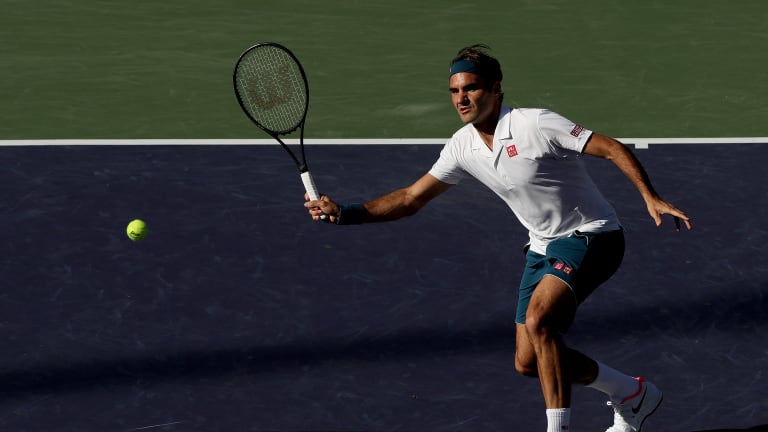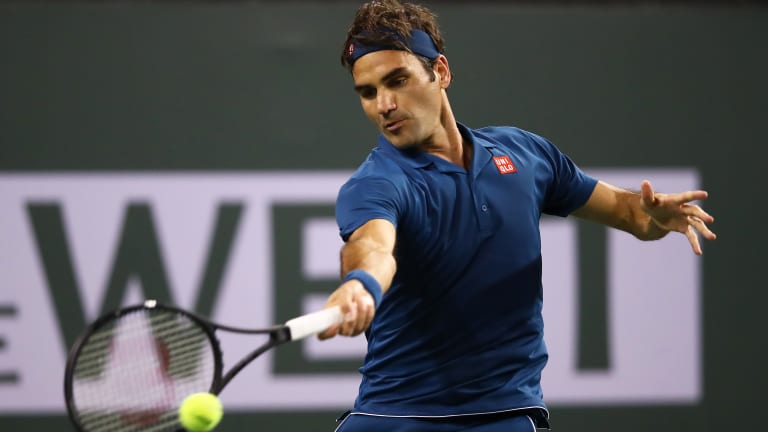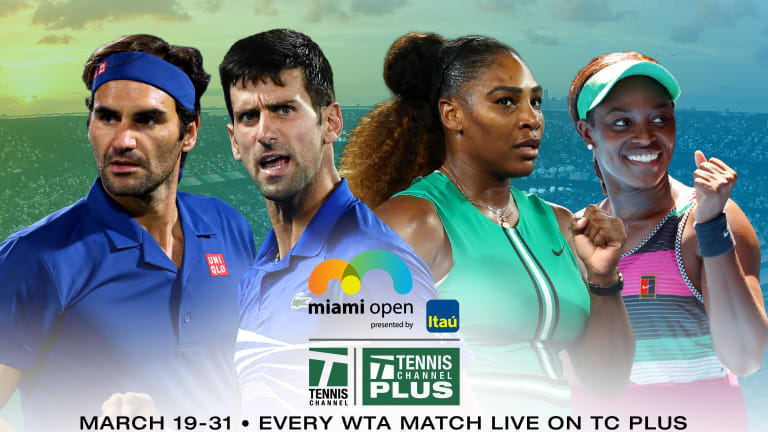Despite some tough losses, Federer remains at forefront of the game
By Steve Flink Mar 19, 2019Searches for "Roger Federer" spike after Eurovision mention
By Baseline Staff May 15, 2025Roger Federer and Caroline Wozniacki step out at the Masters: “So much tradition”
By Baseline Staff Apr 13, 2025Richard Gasquet given Monte Carlo wild card 20 years after breakthrough win over Roger Federer
By Ed McGrogan Apr 03, 2025Wolfgang Puck: The biggest tennis fan in the kitchen?
By Mitch Michals Mar 12, 2025Serena Williams, Roger Federer, Aryna Sabalenka and pickleball all featured during Super Bowl LIX
By Liya Davidov Feb 13, 2025Roger Federer’s Wimbledon-winning racquet sells for more than $100,000 in tennis auction
By Liya Davidov Feb 10, 2025Roger Federer explains tennis scoring, On logo to Elmo in Super Bowl ad
By Baseline Staff Feb 10, 2025Roger Federer’s Wimbledon winning racquet currently up for auction
By Liya Davidov Jan 28, 2025Henry Bernet, Australian Open junior champion, takes inspiration from fellow countrymen Roger Federer and Stan Wawrinka
By Associated Press Jan 25, 2025Despite some tough losses, Federer remains at forefront of the game
The 37-year-old lost to Dominic Thiem in the Indian Wells final, but he is still consistently going deep in tournaments.
Published Mar 19, 2019
Advertising
Among the many fascinating facts surrounding Roger Federer is how often he loses skirmishes that are there for the taking or, at least, not far from his grasp. It happened again Sunday afternoon on the slow, high bouncing, hard courts at Indian Wells when he confronted a top-of-the-line Dominic Thiem in the final of the BNP Paribas Open. Federer was outstanding in the first set of that title-round duel, outplaying the Austrian powerhouse decidedly with some stellar returning off the backhand and masterful play from the backcourt—coupled with uncannily precise serving.
Federer had won 20 consecutive finals after prevailing in the first set. Not since the Wimbledon final of 2014 against none other than Novak Djokovic had he been beaten after coming out on top in an opening set of a title-round meeting. His multitude of admirers and incomparably large number of fierce loyalists eagerly anticipated career tournament triumph No. 101 for the Swiss Maestro, but it was not to be. An unwavering Thiem was supremely disciplined early in the second set, when Federer threatened to seize control of the proceedings and press on to victory.
At 1-1, Thiem erased two break points against him before breaking Federer in the following game. Thiem took that set confidently and then diligently went to work, salvaging an uplifting victory despite having to serve from behind in a hard fought final set. Two moments stand out prominently in the eye of my mind from that stirring final set. The first was Thiem serving at 3-4, 30-40, approaching somewhat cautiously off the forehand, but recognizing that Federer was trapped too far behind the baseline. The 37-year-old missed a backhand pass that was not in the cards. The second instance of Thiem denying Federer in the clutch was when the Austrian served at 4-5, 30-30, standing two points away from a potentially penetrating defeat. Federer applied the pressure, chipping a backhand approach crosscourt. Thiem blasted a backhand pass with all of his might crosscourt, giving Federer absolutely no chance to respond. Thiem held on with temerity for 5-5.
From 30-15 in the 11th game, Federer lost seven of eight points as Thiem closed out the finest hard-court triumph of his career, 3-6, 6-3, 7-5. From the standpoint of the Swiss, he can only lament the drop shots he played when he lost his serve at 5-5. On consecutive points from 30-15, Federer was burned by the speed and determination of his opponent. Thiem chased down both drop shots, delicately angling crosscourt winners off his forehand side. Federer was justified to try the first one, but the second was an inexplicable brain cramp that may have cost him the match.
And so, for the second year in a row, Federer was ousted in the Indian Wells final despite being poised to win. A year ago, Juan Martin del Potro saved three match points to surpass the Swiss. This time around, Federer was within two points of capturing his sixth title on those grounds.

Despite some tough losses, Federer remains at forefront of the game
© Getty Images
Advertising
To be sure, Thiem won this match much more than Federer lost it, but the fact remains that the Swiss was just about where he wanted to be, on the edge of a gratifying victory. Keep turning the pages backwards in the Federer historical book, and the pattern is familiar. At the Australian Open, facing Stefanos Tsitsipas in the round of 16, Federer won the first set and had four set points in the second set—all on the Tsitsipas serve. He did not convert. Tsitsipas eventually recorded a four-set victory against the six-time champion.
In his two losses at the majors in 2018, Federer suffered similar setbacks. At the US Open, he was up a set and ahead double set point on his serve in the second, but John Millman rallied to win their round-of-16 duel under the lights in four sets. At Wimbledon earlier in the summer, Federer squandered a two-set lead and a match point in the third as Kevin Anderson toppled him in a five set quarterfinal showdown. Travel deeper into history, and you will find Federer suffering a litany of hard defeats in consequential contests.
Consider 2005 at the Australian Open. He was the dominant world No. 1, and had a match point in the semifinals against Marat Safin, chasing down a lob over his head and missing an unnecessary tweener. Safin won in five sets. In 2008 at Wimbledon, he made a gallant comeback from two sets down against Rafael Nadal, finding the way into a fifth set, moving within two points of a sixth Centre Court title in a row before the Spaniard took the sport’s premier prize away from him. In 2009 at the US Open, he built a 6-3, 5-4, 30-0 lead against Del Potro in the final, but lost that critical second set and ultimately fell in five sets.
Recall Wimbledon in 2011, when he led two sets to love against Jo-Wilfried Tsonga in the quarters, but bowed out in five. Later that summer, facing Djokovic in the semifinals of the US Open, he served for the match and led 5-3, 40-15 in the fifth set, but was beaten by the highly charged Serbian who had boldly recovered from two sets down. A year earlier, Djokovic also fought off two match points to upend Federer in another five set US Open semifinal encounter.
Don’t get me wrong. Federer has not won 20 of 30 major finals and 100 of 153 finals altogether without being a magnificent competitor and an excellent match player. Only three players—Nadal, Djokovic and Del Potro—have toppled Federer in major finals. He is seldom given the plaudits he deserves for his fighting spirit, poise under pressure and firm resolve. Beating Nadal in a five set 2007 Wimbledon final is one prime example of his mental toughness. His stirring 2017 rally in the Australian Open final from 1-3 in the fifth set on an improbable five-game run past the same indomitable Spanish southpaw was his finest hour as a tennis player. Holding back Marin Cilic in another five-set final at the Australian Open last year is another shining moment. Federer’s grit and gumption have been on prominent display all across his career.

Despite some tough losses, Federer remains at forefront of the game
© Getty Images
Advertising
Meanwhile, his commitment to excellence is undiminished. In 2019, Federer has played three tournaments as he approaches the Miami Open, capturing 12 of 14 matches, winning one title, reaching another final, and releasing some sterling tennis in the process.
But how will it play out from here for the 37-year-old the rest of this year? He has not played a clay-court tournament since the 2016 season, choosing to protect his back and his knee, benefitting from that decision especially in 2017 when he won his eighth Wimbledon. But this year the plan for Federer is to return to Madrid on the red clay and move on to Roland Garros for his first appearance there since 2015.
While it is commendable that Federer genuinely wants to perform again at the premier clay-court theater in Paris, he is taking a considerable risk. The unpredictable and often damp weather in Paris could be detrimental to Federer’s body. Even if he does play well there and reach the latter stages of the tournament, will the physical exertion from playing on the dirt damage him at Wimbledon?
That is a difficult question to answer. The view here is that Federer could hurt his chances to secure a ninth crown on Centre Court by participating again on the dirt. The All England Club is where he has his best remaining chance to rule at another major. On the grass, with his serve still one of the best in the game and the courts suiting his game to the hilt, Federer can definitely be a serious factor if he is healthy.
Why not train and rest for the whole clay-court circuit and get on the grass early? I believe that would have been a safer and more sensible path for Federer as he moves toward his 38th birthday in August. Yet he surely did not make the decision to go back out onto the clay rashly. He is clearly convinced he can make that transition again. He just might be right.
Even if he is correct in his assumptions, however, the crucial issue will be whether or not Federer will lose at Wimbledon and the other majors in the next year or two simply because he comes up short on his less than stellar days. More so, will he flourish on the hard afternoons and demanding evenings when he is embroiled in skirmishes that are hanging in the balance? That is the $64,000 question.
I have my doubts that he will indeed win another major, but it would be foolhardy to count him out. The man’s lingering ambition and work ethic is strikingly apparent. The fact that he is rarely beaten soundly and almost always gives himself a chance to succeed when it counts is indisputable. Moreover, Federer still has that knack for picking apart rivals on his best days with extraordinary ease, verve and ingenuity, conserving energy in the process.
This much is certain: following the trajectory of Federer’s performances through the rest of this year and beyond will be immensely compelling. It is impossible to project when he might retire, or how long he can play at a level that lives up to his exceedingly high standards. I believe he will get enough good things done to finish this year among the top four or five in the world. The guess here is that he will keep going reasonably strong through 2020. He could conceivably be ready to put the racket down permanently by the end of that season, although another year would not be out of the question. All I know is this: Roger Federer will be entirely honest with himself and very wise in determining the right time to bid farewell to the game.

Despite some tough losses, Federer remains at forefront of the game